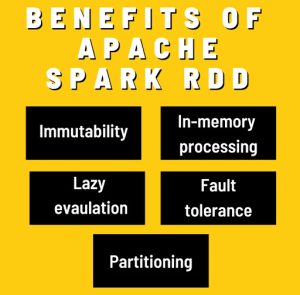 Apache Spark RDD caused a lot of excitement when it was launched. Marketed as a replacement for the outdated Hadoop MapReduce, Apache Spark RDD promised fast, efficient, and flexible big-data processing.
Apache Spark RDD caused a lot of excitement when it was launched. Marketed as a replacement for the outdated Hadoop MapReduce, Apache Spark RDD promised fast, efficient, and flexible big-data processing.
Has it fulfilled that promise? Is Apache Spark RDD still used? Is it a good framework for fast data processing? Let’s find out:
What is Apache Spark RDD?
Apache Spark RDD (Resilient Distributed Datasets) is a flexible, well-developed big data tool. It was created by Apache Hadoop to help batch-producers process big data in real-time.
RDD in Spark is powerful, and capable of processing a lot of data very quickly. App producers, developers, and programmers alike use it to handle big volumes of data in a fast, efficient, and fault-free manner.
Spark RDD is the centerpiece of the Apache ecosystem, including Apache Kudu (Hadoop’s free, open-source storage system). It’s capable of handling huge amounts of data in real-time, making it perfect for things like event streaming.
To properly understand what RDD is and why it’s so useful for Spark, let’s take a look at each part of the acronym:

Resilient
RDDs are fault-tolerant. An RDD can handle large data clusters without lag or error. It achieves this by logging each step in a computation or transformation. If a fault occurs, the RDD can replicate previous steps and rebuild the corrupted data.
Distributed
RDD data is distributed through many nodes within each cluster.
Want More Tech News? Subscribe to ComputingEdge Newsletter Today!
Datasets
RDDs work on ‘clusters’ of partitioned data. This allows the program to consider input files in the same way that they would other variables. This adds an extra degree of flexibility.
What are the benefits of Apache Spark RDD?

Lazy evaluation
Apache Spark works with lazy transformations. This means that it does not compute results. This may sound like a disadvantage, but in fact it gives you a much more comprehensive overview of how the data behaves.
Instead of computing results, Apache Spark tracks transformation tasks using Directed Acyclic Graphs (DAG). That’s not to say you can’t compute results with Spark, however. The program will automatically compute transformations when the driver program needs a result.
In-memory computation
Spark’s in-memory computation process makes processing time a lot faster. With in-memory computation, data is kept in RAM rather than the disk drives. This saves a lot of space, but there’s more to it than that. Just as with Java microservices, programmers using Spark RDD can deal with a lot of data quickly and easily.
By computing within RAM, Spark is more efficient at pattern detection, faster in general at computation, and much more efficient at processing big data.
Immutability
Spark RDD is immutable. This means that the data is immune to a lot of problems which commonly afflict other data processing tools. It is also faster, safer, and easier to share immutable data across processes.
Further, RDDs are not just immutable, they’re also reproducible. If needed, it’s easy to recreate parts of any RDD process. This makes them a very useful resource.
Fault tolerance
RDDs are fault tolerant. They achieve this by tracking processes and data lineages, enabling them to instantly rebuild lost data if a fault occurs.
Partitioning
When dealing with large volumes of data, it is often more efficient to partition datasets and distribute them across nodes within clusters. Spark RDD does this automatically. This allows for parallelism, which speeds up computation time.
Apache Spark RDD: an effective evolution of Hadoop MapReduce
Hadoop MapReduce badly needed an overhaul. and Apache Spark RDD has stepped up to the plate.
Spark RDD uses in-memory processing, immutability, parallelism, fault tolerance, and more to surpass its predecessor. It’s a fast, flexible, and versatile framework for data processing.
If you’re building and testing an app, Apache Spark RDD is a great processing option – especially if you’re handling large amounts of data and testing with rainforest QA alternatives.
About the Author
 Pohan Lin is the Senior Web Marketing and Localizations Manager at Databricks, a global Data and AI provider connecting the features of data warehouses and data lakes to create lakehouse architecture. With over 18 years of experience in web marketing, online SaaS business, and ecommerce growth. Pohan is passionate about innovation and is dedicated to communicating the significant impact data has in marketing. Pohan Lin also published articles for domains such as IT Chronicles.
Pohan Lin is the Senior Web Marketing and Localizations Manager at Databricks, a global Data and AI provider connecting the features of data warehouses and data lakes to create lakehouse architecture. With over 18 years of experience in web marketing, online SaaS business, and ecommerce growth. Pohan is passionate about innovation and is dedicated to communicating the significant impact data has in marketing. Pohan Lin also published articles for domains such as IT Chronicles.
Disclaimer: The author is completely responsible for the content of this article. The opinions expressed are their own and do not represent IEEE’s position nor that of the Computer Society nor its Leadership.